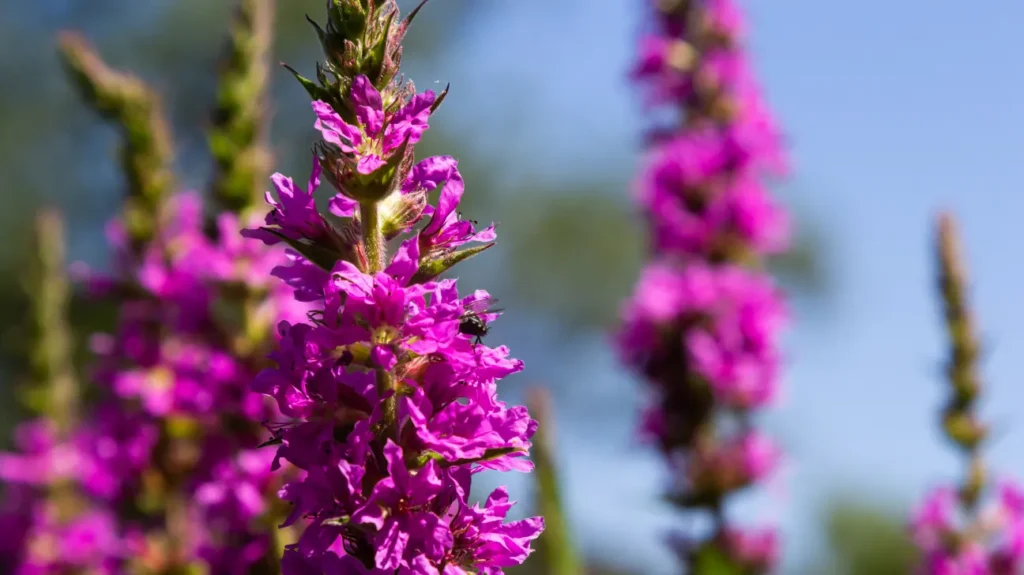Purple loosestrife (Lythrum salicaria) is a perennial herb native to Europe, Asia, and North America, renowned for its striking purple flowers and ability to thrive in wetland environments. Historically, this plant has been utilized in traditional medicine for various ailments, including inflammation and digestive issues. In recent years, purple loosestrife has gained interest as a potential nootropic supplement due to its active compounds and purported cognitive benefits. This article provides an in-depth analysis of purple loosestrife, exploring its sources, chemistry, physiological mechanisms, potential nootropic benefits, dosing guidelines, side effects, drug interactions, and other essential considerations for safe supplementation.
You May Also Like:
Delphinium: Benefits, Dosage, Side Effects, Drug Interactions, and Other Important Information
Sources of Purple Loosestrife
Purple loosestrife can be found growing in various habitats, including marshes, riverbanks, and wetlands. The plant’s rich purple flowers are not only aesthetically pleasing but also indicative of its medicinal properties. The parts of the plant that are typically used for medicinal purposes include:
- Flowers: The vibrant flowers are often harvested for their therapeutic properties, particularly in herbal preparations.
- Leaves: The leaves contain bioactive compounds that contribute to the plant’s overall health benefits.
- Stems: The stems can also be utilized in herbal remedies, although they are less commonly used than the flowers and leaves.
In traditional herbal medicine, purple loosestrife has been employed for its astringent, anti-inflammatory, and diuretic properties, making it a candidate for further research in the field of nootropics.
Maximize Your Mental Potential with Amazon’s Top Nootropic Supplements—Explore Now!

Chemistry of Purple Loosestrife
The chemistry of purple loosestrife is primarily attributed to its active constituents, including flavonoids, tannins, and phenolic compounds. These compounds are responsible for the plant’s various pharmacological effects:
- Flavonoids: This group of polyphenolic compounds is known for its antioxidant properties and ability to modulate neurotransmitter systems. Notable flavonoids found in purple loosestrife include quercetin and kaempferol, which have been shown to exert neuroprotective effects by reducing oxidative stress and inflammation in neural tissues.
- Tannins: These polyphenolic compounds have astringent properties and may contribute to the anti-inflammatory effects of purple loosestrife. Tannins may also promote gastrointestinal health, which is essential for maintaining optimal cognitive function.
- Phenolic Compounds: Various phenolic compounds found in purple loosestrife may exhibit antimicrobial and anti-inflammatory activities, further supporting its use as a herbal remedy.
The precise mechanisms by which these compounds exert their effects on the body and brain remain under investigation, but their presence indicates the potential for cognitive enhancement through the modulation of biochemical pathways associated with brain health.

Physiological Mechanisms of Purple Loosestrife in the Body and Brain
The physiological mechanisms of purple loosestrife involve its active constituents’ interaction with cellular and molecular pathways in the body. Although research on purple loosestrife as a nootropic is limited, the existing evidence points to several key actions:
- Antioxidant Activity: The flavonoids and phenolic compounds in purple loosestrife possess strong antioxidant properties that help combat oxidative stress, a significant contributor to cognitive decline and neurodegenerative diseases. By neutralizing reactive oxygen species (ROS), these compounds may protect brain cells from damage, thereby supporting cognitive function.
- Anti-Inflammatory Effects: Chronic inflammation is linked to various cognitive disorders, including Alzheimer’s disease and other forms of dementia. The anti-inflammatory properties of purple loosestrife, particularly due to its tannin content, may help reduce neuroinflammation and promote overall brain health.
- Neurotransmitter Modulation: Some studies suggest that flavonoids may influence neurotransmitter systems, enhancing mood and cognitive performance. By promoting the synthesis and activity of neurotransmitters such as serotonin and dopamine, purple loosestrife may contribute to improved mental clarity and emotional well-being.
- Gastrointestinal Health: The plant’s astringent properties may support gastrointestinal health, which is crucial for nutrient absorption and overall well-being. A healthy gut is increasingly recognized for its role in cognitive health, as the gut-brain axis facilitates communication between the digestive system and the brain.
Achieve Optimal Rest with Amazon’s Top Picks for Sleeping Supplements—Explore Here!
Nootropic Benefits of Purple Loosestrife
The potential nootropic benefits of purple loosestrife stem from its rich array of bioactive compounds. Although more research is needed to establish its efficacy conclusively, some promising areas of interest include:
- Cognitive Enhancement: The antioxidant and anti-inflammatory properties of purple loosestrife may help enhance cognitive function by protecting neural cells from oxidative damage and promoting a healthy inflammatory response. This could potentially lead to improved memory, focus, and overall mental clarity. Furthermore, by supporting blood flow to the brain, purple loosestrife might also facilitate better oxygen delivery, which is critical for optimal cognitive performance.
- Mood Regulation: By influencing neurotransmitter levels, purple loosestrife may help regulate mood and alleviate symptoms of anxiety and depression. A balanced neurotransmitter environment is essential for maintaining cognitive function and emotional stability. Additionally, the plant’s potential to reduce stress and promote relaxation could contribute to overall well-being, making it a valuable ally in mental health support.
- Neuroprotection: The ability of purple loosestrife to help reduce oxidative stress and inflammation suggests it may have neuroprotective effects, which are crucial for preventing age-related cognitive decline and neurodegenerative diseases. By shielding neurons from damage, it may help maintain the integrity of synaptic connections, ultimately supporting long-term cognitive health. This neuroprotective capacity could also play a role in enhancing learning and memory retention over time.
- Support for Gut Health: Improved gastrointestinal health through the astringent properties of purple loosestrife may enhance nutrient absorption, including essential vitamins and minerals that support cognitive function. A healthy gut microbiome is increasingly recognized for its role in brain health, and purple loosestrife may contribute to this balance by promoting the growth of beneficial gut bacteria. This synergy between gut and brain health may further enhance cognitive performance and emotional regulation.

Dosage and Supplementation Guidelines
As research on purple loosestrife as a nootropic is still in its infancy, there are no established dosing guidelines for this supplement. However, preliminary recommendations based on traditional uses and the concentrations of active compounds in herbal formulations can be outlined:
- General Dosage: Traditional herbal preparations often utilize dried flowers or leaves in the range of 1 to 3 grams per day. This may be considered a starting point for supplementation, but individual responses can vary.
- Supplement Forms: Purple loosestrife is typically available in various forms, including capsules, tinctures, and teas. When selecting a supplement, it is crucial to choose a reputable brand that provides standardized extracts to ensure consistent dosing of active compounds.
- Safety Considerations: Individuals should start with the lowest effective dose and monitor their responses before gradually increasing the dosage. Consulting with a healthcare professional knowledgeable about herbal supplements is advisable for personalized guidance.
Amazon’s Essential Picks for Stress Relief and Mood Boosting Supplements—Discover More!

Side Effects and Safety
Purple loosestrife is generally regarded as safe when used as directed, but potential side effects and safety considerations should be acknowledged:
- Gastrointestinal Disturbances: Some individuals may experience mild gastrointestinal upset, including nausea, diarrhea, or abdominal discomfort, particularly when consuming high doses or concentrated extracts.
- Allergic Reactions: While rare, allergic reactions to purple loosestrife may occur, manifesting as skin rashes, itching, or respiratory issues. Those with known allergies to similar plants should exercise caution.
- Drug Interactions: Purple loosestrife may interact with certain medications, particularly those affecting gastrointestinal function or the central nervous system. Individuals taking prescription medications should consult with a healthcare provider before using purple loosestrife supplements.
Interactions with Other Supplements and Medications
As with any supplement, it is essential to consider potential interactions with other medications or supplements. Some noteworthy interactions include:
- Antidepressants: Since purple loosestrife may influence neurotransmitter levels, it could potentially amplify the effects of certain antidepressants, leading to increased side effects or serotonin syndrome. Monitoring by a healthcare provider is advisable.
- Blood Thinners: The anti-inflammatory properties of purple loosestrife may have implications for individuals taking anticoagulant medications, as it could enhance their effects and increase bleeding risk.
- Gastrointestinal Medications: Given purple loosestrife’s astringent properties, individuals taking medications that affect gut motility should consult their healthcare provider to avoid unintended effects on digestion.
Risks for Individuals with Certain Health Conditions
While purple loosestrife is safe for many, certain health conditions may necessitate caution:
- Gastrointestinal Disorders: Individuals with pre-existing gastrointestinal conditions, such as irritable bowel syndrome (IBS) or inflammatory bowel disease (IBD), should consult their healthcare provider before using purple loosestrife due to its potential effects on gut function.
- Pregnancy and Breastfeeding: Limited research exists on the safety of purple loosestrife during pregnancy and breastfeeding. Therefore, it is advisable to avoid its use unless recommended by a healthcare professional.
- Allergies: Those with allergies to related species, such as other plants in the Lythraceae family, should exercise caution and consult with a healthcare provider prior to supplementation.
Unlock Full-Body Benefits with Amazon’s Best Multivitamins for Brain and Body—Shop Now!

Should You Consider Purple Loosestrife as a Nootropic?
Purple loosestrife presents an intriguing option for those seeking cognitive enhancement and overall brain health support. Its rich profile of bioactive compounds, including flavonoids and tannins, positions it as a potential nootropic supplement with antioxidant, anti-inflammatory, and neurotransmitter-modulating properties. While traditional uses and preliminary studies suggest promising benefits, more robust research is necessary to confirm its efficacy and establish standardized dosing guidelines.
As with any supplement, it is crucial to approach purple loosestrife with caution and to consult with a healthcare professional, particularly if you have pre-existing health conditions or are taking medications that may interact with this herb. By maintaining a balanced perspective on its potential benefits and risks, individuals can make informed decisions about incorporating purple loosestrife into their wellness regimen.

References:
- Antioxidant, anti-inflammatory, anti-nociceptive activities and composition of Lythrum salicaria L. extracts. Retrieved from: https://pubmed.ncbi.nlm.nih.gov/17125946/
- Lythrum salicaria L.—Underestimated medicinal plant from European traditional medicine. A review. Retrieved from: https://www.sciencedirect.com/science/article/abs/pii/S0378874115003426
- The implications of accepting untestedhypotheses: a review of the effectsof purple loosestrife (Lythrum salicaria) in North America. A review. Retrieved from: https://link.springer.com/article/10.1023/A:1008861115557
Important Note: The information contained in this article is for general informational purposes only, and should not be construed as health or medical advice, nor is it intended to diagnose, prevent, treat, or cure any disease or health condition. Before embarking on any diet, fitness regimen, or program of nutritional supplementation, it is advisable to consult your healthcare professional in order to determine its safety and probable efficacy in terms of your individual state of health.
Regarding Nutritional Supplements Or Other Non-Prescription Health Products: If any nutritional supplements or other non-prescription health products are mentioned in the foregoing article, any claims or statements made about them have not been evaluated by the U.S. Food and Drug Administration, and such nutritional supplements or other health products are not intended to diagnose, treat, cure, or prevent any disease.


